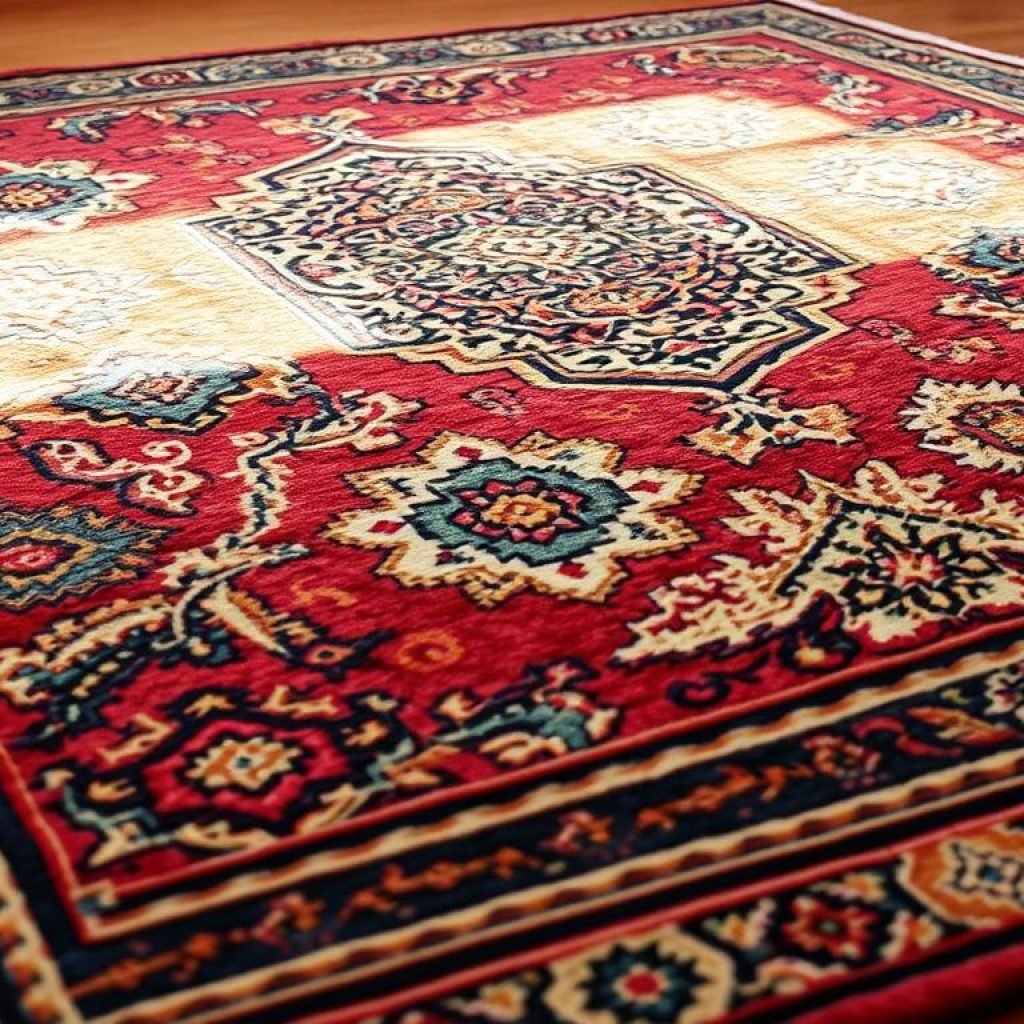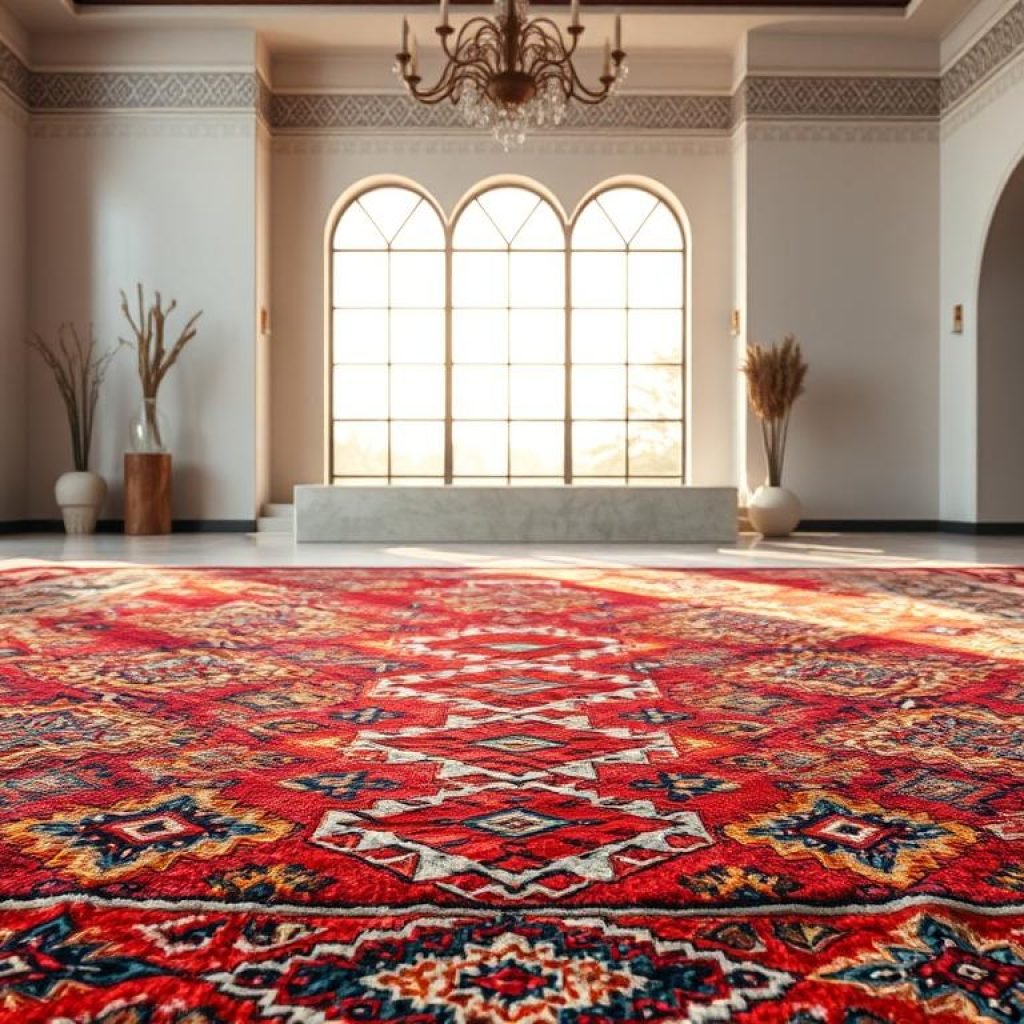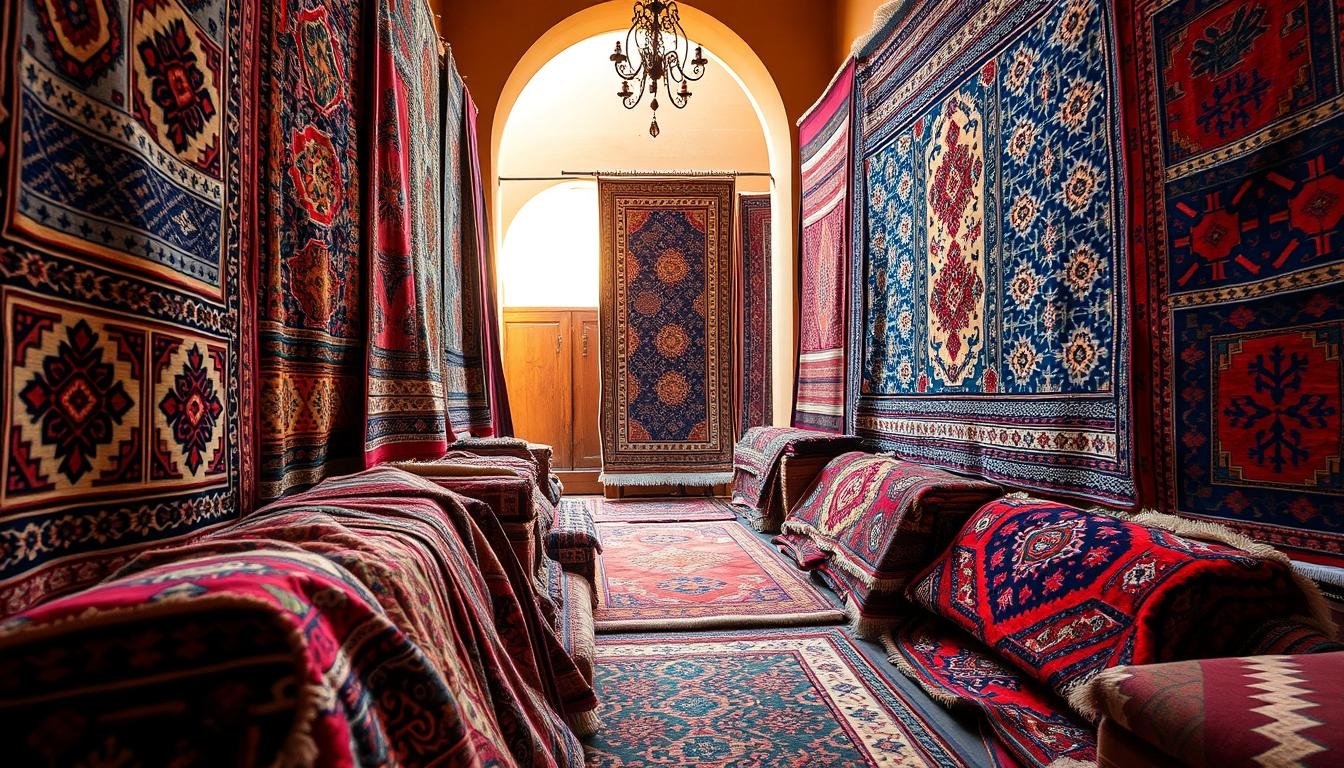What makes Moroccan carpets so unique and sought after? To understand, we must explore their rich history and cultural value. Learning basic Moroccan Arabic phrases can deepen your appreciation for these carpets’ craftsmanship. As you delve into Moroccan carpets, learning the language helps you connect with the artisans and culture.
For those planning a trip to Morocco, visiting local markets is a must. Learning Moroccan Arabic phrases can greatly enhance your experience. It opens doors to a world of beauty and tradition.
Key Takeaways
- Learning basic Moroccan Arabic phrases can enhance your appreciation of Moroccan carpets
- Understanding Moroccan Arabic vocabulary is crucial for connecting with artisans and the culture
- Moroccan carpets are highly sought after by collectors and interior designers
- The history and cultural significance of Moroccan carpets are deeply rooted in the country’s rich heritage
- Visiting local markets and learning Moroccan Arabic phrases can make a significant difference in your travel experience
Origins of Moroccan Arabic
Moroccan Arabic, also known as Darija, has a rich history. It has been shaped by cultures like Berber and nomadic traditions. Learning about its origins helps us appreciate its unique traits and expressions. Common Moroccan Arabic expressions and Moroccan Arabic greetings show the country’s diverse cultural background.
When you travel to Morocco, learning basic Moroccan Arabic phrases is key. Phrases like “لاباس” (labaas), meaning “How are you?” or “سمح(ي) ليا” (smH[ii] liyya), meaning “Excuse me,” are helpful. They help you connect with locals and make your trip better.
The language has three main types: Northern, Eastern, and Western. Each has its own features and way of speaking. For instance, the letters ث and ذ are spoken differently than in Standard Arabic. ث sounds like ت and ذ sounds like د. Also, the definite article “ال” is often left out when adding a possessive pronoun.
Some key features of Moroccan Arabic include:
- Unique pronunciation and vocabulary
- Influence from Berber and European languages
- Distinct dialects and regional variations
Understanding Moroccan Arabic’s origins and features helps learners appreciate the language and culture more. It also improves their ability to communicate with native speakers.
Types of Moroccan Carpets
Moroccan carpets are a big part of the country’s rich culture. They show the different areas and traditions. You’ll find Beni Ourain, Azilal, and Boujad carpets, each with its own special look and Moroccan Arabic words and phrases in their designs.
These carpets often have Moroccan dialect phrases and symbols. This makes them even more special. Let’s dive into what makes each carpet unique:
- Beni Ourain carpets are simple and rustic, made from undyed virgin wool.
- Azilal carpets have medium-length pile and patterns that are geometric or abstract. They often have a light or white background.
- Boujad carpets are known for their detailed geometric patterns and bright colors like red, orange, purple, blue, and pink.
Every carpet has its own story and meaning, showing the Moroccan Arabic words and phrases and traditions. By learning about these differences, we can understand Morocco’s rich culture better. We see how Moroccan dialect phrases are important in the country’s crafts.
The Symbolism Behind Moroccan Carpets
Moroccan carpets are famous for their detailed patterns and bright colors. These colors and patterns hold deep meanings. Learning about the Moroccan Arabic language helps us understand these meanings better.
Exploring the symbolism of Moroccan carpets, we see the importance of Moroccan Arabic conversation essentials. The use of colors, patterns, and motifs reflects the country’s rich culture. This includes Islamic art and Berber traditions.

- Geometric patterns show harmony and balance in nature.
- Floral motifs mean fertility and abundance.
- Animal designs, like birds and lions, stand for strength and courage.
By exploring Moroccan carpets and their symbols, we appreciate the country’s culture more. We also learn about the language and traditions that make this art unique.
Historical Influences on Carpet Design
Moroccan carpets have been shaped by many historical factors. These include Arab-Islamic traditions, trade routes, and colonialism. To fully appreciate these carpets, it’s important to learn Moroccan Arabic phrases and understand their cultural background.
The history of Moroccan carpet weaving goes back to the 8th-10th centuries AD. The Islamic expansion brought complex patterns and Arabic calligraphy. The use of natural dyes and materials like wool, camel hair, and silk shows the country’s rich cultural heritage.
As you learn Moroccan Arabic, you’ll find out about the meaning of different motifs and patterns. For example, the Berber knot symbolizes protection against evil spirits. The Beni Ourain, Azilal, and Boujad styles are unique, each with its own design and color palette.
To understand the historical influences on carpet design, let’s look at a few key factors:
- Arab-Islamic influence: Introduced complex patterns and Arabic calligraphy
- Trade routes: Facilitated cultural exchanges and the introduction of new materials and techniques
- Colonial impact: Led to the use of synthetic dyes and European design influences
By exploring the historical context of Moroccan carpet design and learning Moroccan Arabic phrases, you’ll appreciate the craftsmanship and cultural significance of these beautiful textiles even more.
Modern Moroccan Carpets
Modern Moroccan carpets blend old and new styles, showing the country’s changing culture. They use Moroccan Arabic words and sayings, making them special. For example, the Boucherouite rug style became famous after the “Rags to Richesse” exhibition. It shows how Moroccan women use old materials in creative ways.
These carpets are made with old techniques and green practices. Artisans use recycled stuff like cotton and plastic to make colorful designs. This helps the environment and supports local jobs. New styles, like the Azilal rug, have come up because of global interest. They have cool patterns and colors.

Modern Moroccan carpets are versatile, strong, and simple to keep clean. Boucherouite rugs, for instance, are easy to wash in a machine. They’re great for homes with kids and pets. The use of Moroccan Arabic in their making adds to their cultural value.
In summary, modern Moroccan carpets show the country’s rich culture and its ability to evolve. Moroccan artists mix old methods, green practices, and new styles. They make carpets that people all over the world want to buy.
Authentic vs. Imitation Carpets
When you’re looking for Moroccan carpets, it’s key to know the difference between real and fake ones. Learning Moroccan Arabic greetings and Moroccan Arabic words and phrases can guide you. Real Moroccan carpets are made by hand. They show off the country’s deep culture through their unique designs.
To find true Moroccan carpets, look for certain signs. They should have uneven designs, be made of natural stuff, and have detailed knotting. Fake carpets, however, have even patterns and are made of synthetic materials. Here are some ways to tell if a carpet is real:
- Check the knotting: Hand-knotted carpets have unique, irregular knots, while machine-made carpets have uniform knots.
- Examine the materials: Authentic Moroccan carpets are made from natural materials such as wool, cotton, or silk.
- Look for asymmetry: Genuine Moroccan carpets often feature asymmetrical designs, which are a hallmark of handmade craftsmanship.
Knowing the difference between real and fake Moroccan carpets helps you make a better choice. You’ll appreciate the beauty and skill that goes into these special pieces.
Caring for Your Moroccan Carpet
To keep your Moroccan carpet looking great, it’s key to know how to care for it. Learning Moroccan dialect phrases can also deepen your appreciation for these beautiful items. For those learning Moroccan Arabic language, understanding carpet weaving is a great addition.
Regular cleaning is vital to make your Moroccan carpet last longer. Here are some tips to remember:
- Vacuum your carpet often to get rid of dirt and dust
- Quickly clean spills to avoid stains
- Get professional cleaning once a year, or when needed
For tough stains, try a mix of distilled vinegar and cold water. Let it sit for at least 10 minutes before blotting. Make sure your carpet dries completely, which can take 12-24 hours depending on the weather.
By following these care tips and learning about Moroccan Arabic language, you can enjoy your Moroccan carpet for many years. Whether you’re into Moroccan dialect phrases or just want to appreciate the craftsmanship, proper care is crucial.
The Future of Moroccan Carpet Weaving
Looking ahead, Moroccan carpet weaving faces challenges and the rise of technology. Knowing Moroccan Arabic conversation essentials and Moroccan Arabic phrases offers deep insights into this craft. The traditional weaving process is manual, lasting two to three weeks without any machines.
Artisans use hand-dyed wool and the Berber knot technique, which holds a special blessing. Supporting local artisans and those who finance the looms is key. This support helps keep the craft alive and boosts women’s economic status in these areas.
- Promoting cultural exchange and understanding through Moroccan Arabic conversation essentials and Moroccan Arabic phrases
- Supporting local artisans and preserving traditional weaving techniques
- Embracing technology to enhance the weaving process while maintaining its cultural significance
Together, we can tackle these challenges and ensure a bright future for Moroccan carpet weaving. This will benefit the artisans who pour their hearts into this ancient craft.
Conclusion: The Charm of Moroccan Carpets
Moroccan carpets are more than just decorations. They show Morocco’s rich culture and the skill of traditional artisans. They also invite us to learn Moroccan Arabic and dive into the lively Moroccan culture.
Buying a real Moroccan carpet is more than a purchase. It’s a chance to connect with Morocco’s traditions and help weavers. These carpets add beauty to your home and teach you about Moroccan Arabic and its stories.
Moroccan carpet weaving has lasted for centuries, thanks to generations of artisans. Each carpet is a special piece, showing the creativity of Berber and Arab-Islamic cultures. By keeping this tradition alive, we ensure Moroccan carpets continue to amaze and inspire everyone.




Comment (0)